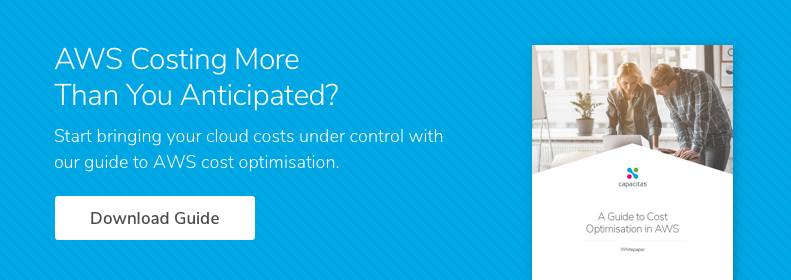With 83% of all enterprise workloads set to be run on public clouds by next year, cloud services have evolved from the technology of tomorrow to the backbone of modern business in a relatively short period of time. This transition has also seen cloud spend becoming one of the most important OPEX areas for enterprises, indeed, according to Gartner, $1.3 trillion in IT spending will be directly or indirectly affected by the shift to the cloud by 2022.
The problem is a lot of this spend is unnecessary; some estimates put the percentage of cloud expenditure wasted each year as high as 35%.
So, you could be forgiven for thinking that developing a strategy for optimising cloud costs would be at the head of most CIO’s list of priorities. In reality, many are missing the opportunity through a blend of poor awareness, nervousness on how to approach it, and misunderstanding what’s involved.
“I Already use a Cloud Cost tracker or Capacity Monitoring Tool”
To clarify, there is nothing wrong with using cost trackers or capacity monitoring tools. Software like AWS CloudWatch is a great place to start with optimising costs. However, it isn’t without its limitations.
Firstly, these tools are only as useful as your understanding of their recommendations. We often work with clients who are using some form of cloud optimisation tool but have only implemented a fraction of its recommendations.
Even if you are using these tools to their full potential, the optimisations they prescribe are only a fraction of what you could achieve with a more strategic approach. While great for delivering early savings and cutting basic overprovisioning, more lasting benefits are to be found in working on deep-seated structural issues – such as cloud architecture inefficiency.
For this, you need a means of assessing what ‘good’ efficiency looks like for your organisation and a methodology for getting there. Unfortunately, both of these go beyond the remit of a monitoring tool – which, at best, can only tell you where you’re overspending .There really is no substitute for taking the time to develop a comprehensive strategy for tackling inefficiency or enlisting a specialist to help.
“Optimising Cloud-Spend isn’t the Highest Priority Project right now”
Admittedly, how ill-advised this objection is will depend on what is happening in your business. If you’re going through a major restructure, then, sure, optimising your cloud costs is a low priority task. However, this isn’t the reason most businesses neglect to prioritise cloud spending until it begins to spiral.
In large part, it’s often down to poor awareness of how much can be saved by a thorough optimisation program. Large businesses, particularly those with the bulk of their trade conducted online, are often amazed at how much they’re actually spending on unneeded cloud architecture.
To illustrate, we recently worked with a major telecoms provider that was able to save £26m on excess cloud spend through a combination of rightsizing and accurate forecasting. While the client knew they were using more capacity than needed, even they were surprised at the scale of their overspending.
This is an extreme example but, if your excess cloud spend is even a fraction of that figure, can you really afford not to prioritise addressing it?
“My Data isn’t Good Enough”
This is a common complaint among CIOs who are aware of unnecessary spending but lack the confidence to go beyond basic rightsizing. If your organisation is a recent cloud convert, chances are you’ll know if you’re spending too much – it’ll be there in black and white on your monthly bill – but you might not necessarily know why.
The problem is simple: without using cloud services for a number of years, you won’t have enough data to accurately benchmark what you should be spending or even what that looks like. This makes confronting issues like inefficiency or inaccurate forecasting difficult, however, this doesn’t mean you have to be resigned to leaking OPEX costs.
There are still options open to you even if you don’t have the data needed for benchmarking. Of course, you can follow the recommendations of your cost tracking and monitoring software and use a basic optimisation methodology to attack some of the low-hanging fruit. For more systemic fixes, a capacity management specialist can give you access to their library of efficiency benchmarks, help you develop your own, and give you pointers on the best strategy for your business moving forward.
“I Don’t Know How to Make a Business Case for It”
If you’re finding it difficult to make a business case for developing a cost optimisation strategy, then it’s likely your overspending isn’t too pronounced, yet. If left unchecked, the impact on your business is only going to grow alongside your cloud footprint.
Your business case needs to focus on the opportunity-cost delaying presents. Without a proven optimisation strategy and accurate spend forecasting, your organisation will end up fighting a running battle with spiralling OPEX costs.
Besides, why begin putting a strategy in place after your spending becomes a problem and you’ve wasted large sums on cloud architecture that isn’t needed? It’s simply good sense to address the issue while it’s relatively minor and adopt a methodology that allows you to future-proof your spending. When making the case to the board or the rest of the C-suite, it’s worth stressing that optimising cloud costs should be seen as an investment – in much the same way as hiring staff or procuring new software.
The cloud is well and truly here to stay and – if it isn’t already – it won’t be long until it’s seen as just as integral to a business’s success as its staff or the bricks and mortar that house it. So, while it may appear a low priority or something that can be put-off, developing a comprehensive strategy to keep your cloud costs under control won’t just pay dividends today, it’s also a vital part of your organisation’s future.


